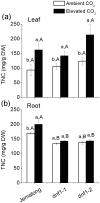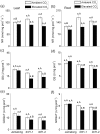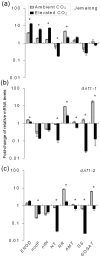Elevated CO(2) modifies N acquisition of Medicago truncatula by enhancing N fixation and reducing nitrate uptake from soil
- PMID: 24339920
- PMCID: PMC3855279
- DOI: 10.1371/journal.pone.0081373
Elevated CO(2) modifies N acquisition of Medicago truncatula by enhancing N fixation and reducing nitrate uptake from soil
Abstract
The effects of elevated CO2 (750 ppm vs. 390 ppm) were evaluated on nitrogen (N) acquisition and assimilation by three Medicago truncatula genotypes, including two N-fixing-deficient mutants (dnf1-1 and dnf1-2) and their wild-type (Jemalong). The proportion of N acquisition from atmosphere and soil were quantified by (15)N stable isotope, and N transportation and assimilation-related genes and enzymes were determined by qPCR and biochemical analysis. Elevated CO2 decreased nitrate uptake from soil in all three plant genotypes by down-regulating nitrate reductase (NR), nitrate transporter NRT1.1 and NR activity. Jemalong plant, however, produced more nodules, up-regulated N-fixation-related genes and enhanced percentage of N derived from fixation (%Ndf) to increase foliar N concentration and N content in whole plant (Ntotal Yield) to satisfy the requirement of larger biomass under elevated CO2. In contrast, both dnf1 mutants deficient in N fixation consequently decreased activity of glutamine synthetase/glutamate synthase (GS/GOGAT) and N concentration under elevated CO2. Our results suggest that elevated CO2 is likely to modify N acquisition of M. truncatula by simultaneously increasing N fixation and reducing nitrate uptake from soil. We propose that elevated CO2 causes legumes to rely more on N fixation than on N uptake from soil to satisfy N requirements.
Conflict of interest statement
Figures






Similar articles
-
Pea aphid promotes amino acid metabolism both in Medicago truncatula and bacteriocytes to favor aphid population growth under elevated CO2.Glob Chang Biol. 2013 Oct;19(10):3210-23. doi: 10.1111/gcb.12260. Epub 2013 Jul 15. Glob Chang Biol. 2013. PMID: 23686968
-
Free-air CO2 enrichment (FACE) reduces the inhibitory effect of soil nitrate on N2 fixation of Pisum sativum.Ann Bot. 2016 Jan;117(1):177-85. doi: 10.1093/aob/mcv140. Epub 2015 Sep 7. Ann Bot. 2016. PMID: 26346721 Free PMC article.
-
Elevated CO2 decreases the response of the ethylene signaling pathway in Medicago truncatula and increases the abundance of the pea aphid.New Phytol. 2014 Jan;201(1):279-291. doi: 10.1111/nph.12484. Epub 2013 Sep 10. New Phytol. 2014. PMID: 24015892
-
[Research advance in nitrogen metabolism of plant and its environmental regulation].Ying Yong Sheng Tai Xue Bao. 2004 Mar;15(3):511-6. Ying Yong Sheng Tai Xue Bao. 2004. PMID: 15228008 Review. Chinese.
-
Balancing nitrate acquisition strategies in symbiotic legumes.Planta. 2023 Jun 9;258(1):12. doi: 10.1007/s00425-023-04175-3. Planta. 2023. PMID: 37296318 Free PMC article. Review.
Cited by
-
Control of the rhizobium-legume symbiosis by the plant nitrogen demand is tightly integrated at the whole plant level and requires inter-organ systemic signaling.Front Plant Sci. 2023 Mar 9;14:1114840. doi: 10.3389/fpls.2023.1114840. eCollection 2023. Front Plant Sci. 2023. PMID: 36968361 Free PMC article. Review.
-
Potential effects of a high CO2 future on leguminous species.Plant Environ Interact. 2020 Apr 24;1(2):67-94. doi: 10.1002/pei3.10009. eCollection 2020 Sep. Plant Environ Interact. 2020. PMID: 37283729 Free PMC article. Review.
-
Signalling and regulation of plant development by carbon/nitrogen balance.Physiol Plant. 2025 Mar-Apr;177(2):e70228. doi: 10.1111/ppl.70228. Physiol Plant. 2025. PMID: 40269445 Free PMC article. Review.
-
Responses in Nodulated Bean (Phaseolus vulgaris L.) Plants Grown at Elevated Atmospheric CO2.Plants (Basel). 2023 Apr 29;12(9):1828. doi: 10.3390/plants12091828. Plants (Basel). 2023. PMID: 37176886 Free PMC article.
-
Interaction of Nitrate Assimilation and Photorespiration at Elevated CO2.Front Plant Sci. 2022 Jul 1;13:897924. doi: 10.3389/fpls.2022.897924. eCollection 2022. Front Plant Sci. 2022. PMID: 35845694 Free PMC article.
References
-
- IPCC-WGI (2007) Climate Change 2007: The Physical Science Basis. Contribution of Working Group I to the Fourth Assessment Report of the Intergovernmental Panel on Climate Change. Solomon S, Qin D, Manning M, Chen Z, Marquis M, Averyt KB, Tignor M, Miller HL, editors. CambridgeUK: Cambridge University Press. 1009 p.
-
- Ainsworth EA, Long SP (2005) What have we learned from 15 years of free-air CO2 enrichment (FACE)? A meta-analytic review of the responses of photosynthesis, canopy properties and plant production to rising CO2 . New phytol 165: 351–372. - PubMed
-
- Ainsworth EA, Rogers A (2007) The response of photosynthesis and stomatal conductance to rising [CO2]: mechanisms and environmental interactions. Plant Cell Environ 30: 258–270. - PubMed
-
- Taub DR, Miller B, Allen H (2008) Effects of elevated CO2 on the protein concentration of food crops: a meta-analysis. Global Change Biol 14: 565–575.
-
- Taub DR, Wang X (2008) Why are nitrogen concentrations in plant tissues lower under elevated CO2? A critical examination of the hypotheses. J Integr Plant Biol 50: 1365–1374. - PubMed
Publication types
MeSH terms
Substances
LinkOut - more resources
Full Text Sources
Other Literature Sources

